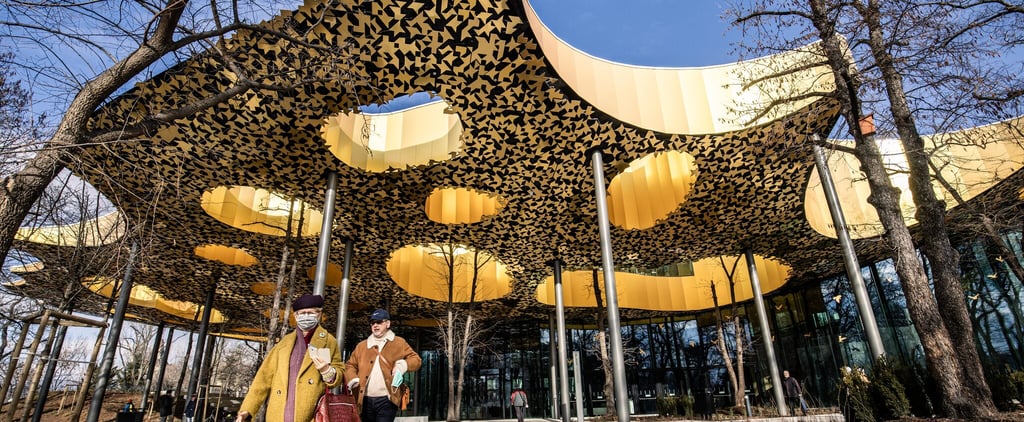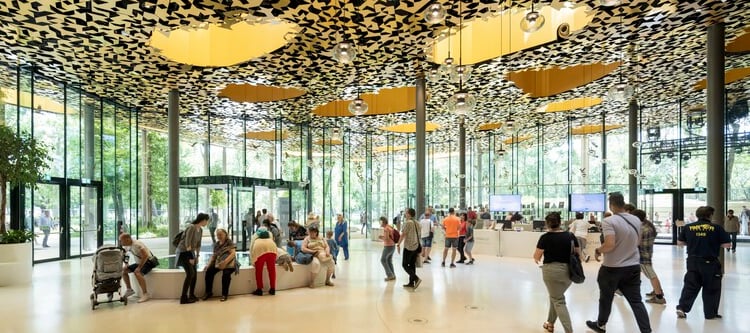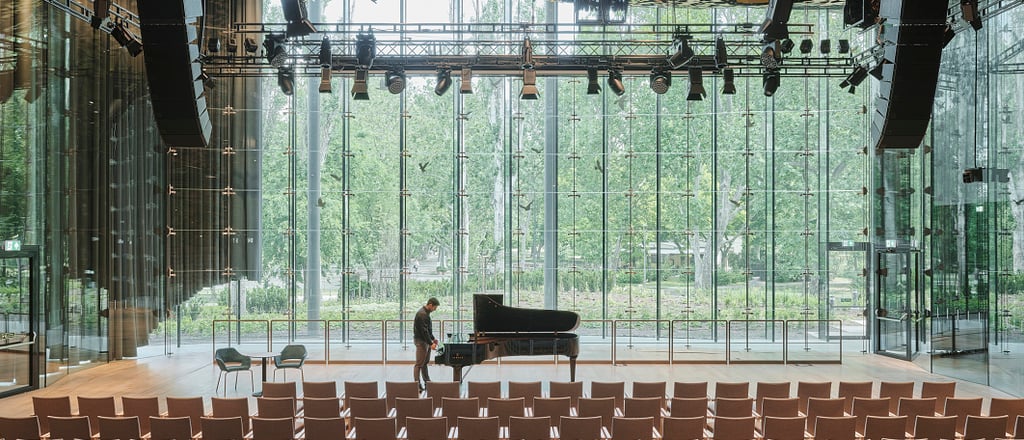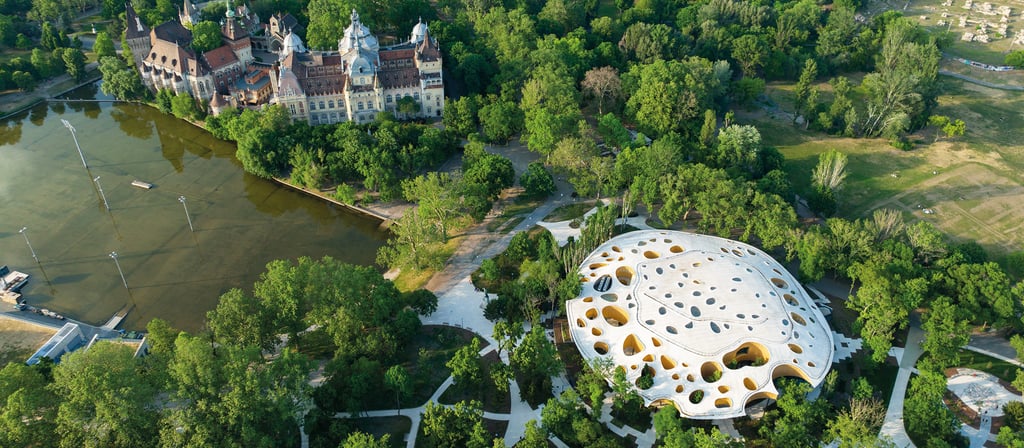House of Music Hungary: A Cathedral of Sound and Light
Wander through a forest of glass and music, where architecture hums and memories resonate like echoing chords.


A Dream Rising in the Park
In the heart of Budapest’s City Park, nestled beneath the rustling canopy of ancient trees, a dream has risen—curved like a melody, translucent like morning light, bold as a crescendo. The House of Music Hungary is not merely a building. It is a living instrument, a breathing auditorium, a sculpture of sound and silence. Here, architecture does not stand still—it sings.
Designed by the visionary Japanese architect Sou Fujimoto, the House of Music opened its doors in January 2022 as one of the crown jewels of the Liget Budapest Project—Europe’s largest cultural urban development. It was created not to merely host music, but to embody it. With a roofline that floats like a leaf in the wind and walls of glass that dissolve into the surrounding trees, it is at once grounded and otherworldly.
Sou Fujimoto’s creation defies definition: part concert hall, part interactive museum, part sanctuary. The structure refuses to impose itself on the park—instead, it nestles into it. From a distance, it appears like a shimmering pool of sound, as if music had liquefied and settled gently among the elms.
The Architecture: Nature as Instrument
The first thing you notice is the roof—an undulating golden canopy pierced with over 100 irregularly shaped skylights. These openings are not arbitrary; they are calculated, like notes in a fugue, allowing sunlight to rain into the building in ever-shifting patterns. The effect is magical: the sunlight dances across the floors and walls like soundwaves made visible.
Fujimoto envisioned the building as a place where architecture would disappear—where the boundaries between inside and outside, art and life, music and silence would blur. The glass walls allow the park to flow in. Trees stand just outside, visible from every angle, and their rustling becomes part of the score. You can walk through the building and still feel like you're in nature. Or perhaps it’s the other way around: nature has entered the concert hall.
The building spans three levels: underground galleries that delve into the origins of sound, a ground floor of concerts and community, and a green roof that gestures toward the sky. It is not merely a container for culture—it is an ecosystem of creation.
Sound Dimensions: A Journey Through Time and Tone
Beneath the forest-light of the upper levels lies the Sound Dimensions exhibition—a permanent, immersive journey through the world of music. But this is no dusty timeline of composers and dates. It is a sensory voyage, a pilgrimage through the evolution of music across space, time, and soul.
The exhibition begins with the earliest human impulses: the rhythms of the drum, the heartbeat, the call and response of voice. You travel through prehistoric instruments, Gregorian chants, folk melodies, Baroque intricacy, Romantic fire, jazz improvisation, and electronic experimentation. Along the way, you do not simply observe—you participate.
There are interactive installations where your movement generates harmonics. A walk through a corridor plays scales that rise with your footsteps. You place headphones on and step into the reimagined worlds of Liszt and Bartók, feeling their compositions unfurl in the language of shadow and light. You are not just learning music; you are being enfolded in it.
Sound Dimensions is designed to be accessible to all ages and backgrounds. Whether you're a conservatory student or a curious child, it reveals that music is not elite—it is elemental. It lives in all of us.
A Concert Hall Like No Other
Amidst all the exploration and experimentation, the heart of the House of Music Hungary still beats to the rhythm of live performance. Its intimate concert hall, modest in size but majestic in acoustics, is unlike any other in Budapest—or the world.
Designed with organic shapes and curved wooden surfaces, the hall functions as both a performance space and a resonance chamber. There is no sense of separation between stage and seat; you are part of the sound, not just a spectator to it. The hall regularly hosts:
Chamber concerts
Jazz evenings
Experimental music nights
Traditional folk and world music events
Cross-genre collaborations
The programming is intentionally eclectic. You might attend a performance of Bartók's string quartets one night and return the next for a Korean drumming ensemble or an electronic soundscape experience. The space itself adapts to each performance like a living organism—subtle, sensitive, perfectly attuned.
Even the outdoor garden stage is used in warmer months, where music pours into the trees and passersby pause beneath the canopy of leaves to catch a few magical notes. Here, music is democratic. It flows freely. It invites.
A Place for All People
One of the most remarkable aspects of the House of Music Hungary is its radical inclusivity. This space belongs to everyone: the curious traveler, the elderly local, the school group, the classically trained pianist, the wide-eyed toddler pressing buttons in the Sound Playground.
The building is fully accessible, both physically and intellectually. Exhibitions are multilingual, interactive, and designed to awaken wonder. The entry prices are structured to be affordable, and special programs ensure that underprivileged communities also find their place in the echo of this house.
It is not elitist. It is not cold. It is not for the few. It is a love letter to the many languages music speaks—and to the human capacity to listen, feel, and create.
Café, Gift Shop, and Lingering Moments
After you’ve wandered the glass corridors and reverberated in the dome, take time to rest. The House of Music café offers a warm and minimalist retreat, with sunlight pouring through its transparent walls. The menu celebrates Hungarian ingredients and international simplicity—coffee, herbal teas, pastries, and light meals.
Nearby, the gift shop curates high-quality music-themed items: Hungarian-made instruments, design objects, vinyl records, art prints, and unique souvenirs. But the true gift is intangible. It is the echo that stays with you, long after you've walked away.
Visiting Information
📍 Location
House of Music Hungary
Olof Palme sétány 3–5, 1146 Budapest, Hungary
(Located in the renewed City Park near Vajdahunyad Castle and Heroes’ Square)
🕰 Opening Hours
Tuesday to Sunday: 10:00 AM – 6:00 PM
Friday extended hours: until 8:00 PM
Closed on Mondays
🎫 Ticket Prices
Prices may vary depending on exhibitions and events. Here are base admission fees:
Adults: HUF 4,500 (~$13)
Students/Seniors (EU): HUF 2,700 (~$8)
Children under 6: Free
Additional charges apply for Sound Dome experiences and some concerts
Discounted and combo tickets are available for families and large groups. Entry to the building’s public areas (café, gift shop, and outdoor zones) is free.
♿ Accessibility
The building is fully wheelchair-accessible. Headphones and visual content are designed for all abilities, and attendants of guests with disabilities receive a 50% discount.
Official Website and Social Media
📘 Facebook: https://www.facebook.com/zenehaza
📷 Instagram: https://www.instagram.com/zenehaza
📺 YouTube: https://www.youtube.com/@zenehaza


A Dream Rising in the Park
In the heart of Budapest’s City Park, nestled beneath the rustling canopy of ancient trees, a dream has risen—curved like a melody, translucent like morning light, bold as a crescendo. The House of Music Hungary is not merely a building. It is a living instrument, a breathing auditorium, a sculpture of sound and silence. Here, architecture does not stand still—it sings.
Designed by the visionary Japanese architect Sou Fujimoto, the House of Music opened its doors in January 2022 as one of the crown jewels of the Liget Budapest Project—Europe’s largest cultural urban development. It was created not to merely host music, but to embody it. With a roofline that floats like a leaf in the wind and walls of glass that dissolve into the surrounding trees, it is at once grounded and otherworldly.
Sou Fujimoto’s creation defies definition: part concert hall, part interactive museum, part sanctuary. The structure refuses to impose itself on the park—instead, it nestles into it. From a distance, it appears like a shimmering pool of sound, as if music had liquefied and settled gently among the elms.
The Architecture: Nature as Instrument
The first thing you notice is the roof—an undulating golden canopy pierced with over 100 irregularly shaped skylights. These openings are not arbitrary; they are calculated, like notes in a fugue, allowing sunlight to rain into the building in ever-shifting patterns. The effect is magical: the sunlight dances across the floors and walls like soundwaves made visible.
Fujimoto envisioned the building as a place where architecture would disappear—where the boundaries between inside and outside, art and life, music and silence would blur. The glass walls allow the park to flow in. Trees stand just outside, visible from every angle, and their rustling becomes part of the score. You can walk through the building and still feel like you're in nature. Or perhaps it’s the other way around: nature has entered the concert hall.
The building spans three levels: underground galleries that delve into the origins of sound, a ground floor of concerts and community, and a green roof that gestures toward the sky. It is not merely a container for culture—it is an ecosystem of creation.
Sound Dimensions: A Journey Through Time and Tone
Beneath the forest-light of the upper levels lies the Sound Dimensions exhibition—a permanent, immersive journey through the world of music. But this is no dusty timeline of composers and dates. It is a sensory voyage, a pilgrimage through the evolution of music across space, time, and soul.
The exhibition begins with the earliest human impulses: the rhythms of the drum, the heartbeat, the call and response of voice. You travel through prehistoric instruments, Gregorian chants, folk melodies, Baroque intricacy, Romantic fire, jazz improvisation, and electronic experimentation. Along the way, you do not simply observe—you participate.
There are interactive installations where your movement generates harmonics. A walk through a corridor plays scales that rise with your footsteps. You place headphones on and step into the reimagined worlds of Liszt and Bartók, feeling their compositions unfurl in the language of shadow and light. You are not just learning music; you are being enfolded in it.
Sound Dimensions is designed to be accessible to all ages and backgrounds. Whether you're a conservatory student or a curious child, it reveals that music is not elite—it is elemental. It lives in all of us.












